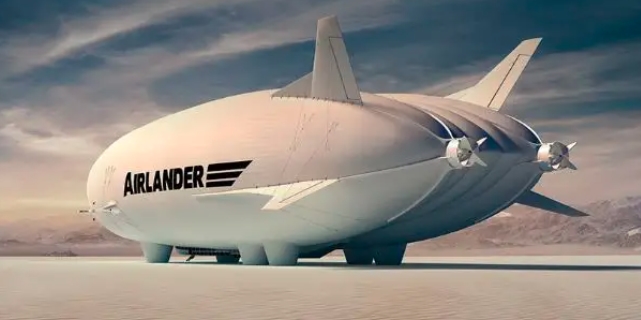The Airlander 10, a hybrid airship that combines the features of a plane and a blimp, could be the future of cargo transportation in Scotland’s remote regions. A recent study has shown that the Airlander 10 could carry more freight than conventional aircraft and operate from various landing sites across the country.
What is the Airlander 10 and how does it work?
The Airlander 10 is a massive aircraft that measures 302 feet (92 meters) in length, making it the world’s longest. It has a helium-filled hull that provides buoyancy and four diesel engines that propel it forward. It can fly at speeds of up to 80 knots (92 mph or 148 km/h) and reach altitudes of up to 16,000 feet (4,880 meters).
The Airlander 10 can take off and land vertically, like a helicopter, and does not need a runway. It can also hover in one place for up to five days. It has a payload capacity of 10 tonnes (22,000 lbs) and can carry up to 100 passengers or various types of cargo. It is designed to be environmentally friendly, with low noise and emissions, and can operate in harsh weather conditions.
Why is the Airlander 10 suitable for Scotland?
Scotland has many remote and rural areas that are difficult to access by road or conventional aircraft. These areas often rely on ferry services or small planes for freight delivery, which can be expensive, slow, and unreliable. The Airlander 10 could offer a faster, cheaper, and more reliable alternative for transporting goods and people across the country.

A study by Hitrans, Highlands and Islands Enterprise, Orkney Islands Council, and Loganair found that the Airlander 10 could provide 79% more cargo than was carried on air routes in Scotland in 2021. The study also identified potential landing sites for the Airlander 10 in Orkney, Shetland, Western Isles, and the Highlands. The Airlander 10 could operate from these sites using existing infrastructure or minimal modifications.
What are the benefits of using the Airlander 10?
The Airlander 10 could bring many benefits to Scotland’s economy, society, and environment. Some of these benefits are:
- Reduced costs: The Airlander 10 could lower the cost of freight delivery by up to 50%, compared to conventional aircraft. This could make goods more affordable and accessible for remote communities.
- Increased capacity: The Airlander 10 could carry more freight than conventional aircraft, which could boost trade and commerce in Scotland. It could also carry oversized or irregular cargo that would not fit in other planes.
- Improved connectivity: The Airlander 10 could connect remote regions with each other and with the rest of the country. This could enhance social inclusion, tourism, health care, education, and emergency services.
- Lower emissions: The Airlander 10 could reduce greenhouse gas emissions by up to 75%, compared to conventional aircraft. This could help Scotland achieve its net-zero carbon target by 2045.
- Greater innovation: The Airlander 10 could stimulate innovation and creativity in Scotland’s aviation sector. It could also create new jobs and skills for local workers.
What are the challenges of using the Airlander 10?
The Airlander 10 is still in development and has not yet been certified for commercial use. It faces some technical and regulatory challenges before it can be deployed in Scotland. Some of these challenges are:
- Safety: The Airlander 10 has to prove that it is safe and reliable to fly in various weather conditions and scenarios. It also has to comply with aviation standards and regulations.
- Infrastructure: The Airlander 10 has to find suitable landing sites that can accommodate its size and weight. It also has to ensure that it does not interfere with other air traffic or cause noise or visual pollution.
- Public perception: The Airlander 10 has to overcome public skepticism and resistance to its unconventional appearance and operation. It also has to demonstrate its value and benefits to potential customers and stakeholders.
What is the future of the Airlander 10?
The Airlander 10 is expected to enter service by 2025, according to its developer Hybrid Air Vehicles (HAV). HAV plans to produce up to 24 new aircraft per year at a purpose-built facility in South Yorkshire, creating 1,200 jobs. HAV also aims to develop an all-electric version of the Airlander 10 that would have zero carbon emissions.
The Airlander 10 has already attracted interest from various sectors and markets around the world. It has potential applications in tourism, leisure, defense, humanitarian aid, surveillance, research, and exploration. It could also open up new opportunities for regional development and integration.
The Airlander 10 is a unique and innovative aircraft that could transform the way we transport goods and people in Scotland and beyond. It could offer a greener, cheaper, and more efficient alternative to conventional aircraft, while also enhancing the quality of life and well-being of remote communities. However, it also faces some challenges and uncertainties that need to be resolved before it can become a reality. Will the Airlander 10 soar to new heights or crash and burn? Only time will tell.


















